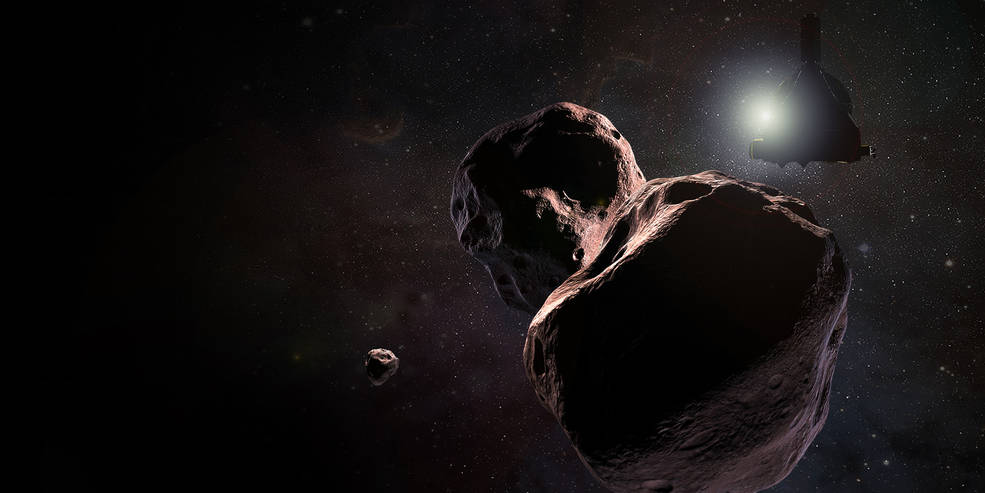You Can Beam a Message to NASA's New Horizons Spacecraft for Historic Flyby!
NASA's New Horizons probe is getting set for the farthest-out flyby in history, and you can provide some words of encouragement to help the spacecraft get across the finish line.
The mission team is asking people around the world to send greetings to New Horizons, which will zoom by the small object Ultima Thule on Jan. 1. Ultima Thule lies about 1 billion miles (1.6 billion kilometers) beyond Pluto, the target of New Horizons' first flyby — which means the upcoming encounter will take place more than 4 billion miles (6.4 billion km) from Earth.
"Traveling at light speed, the signals carrying these messages will reach the spacecraft about six hours after being beamed from the Applied Physics Lab's largest dish antenna, on the very same day that New Horizons flies by Ultima Thule!" New Horizons principal investigator Alan Stern, of the Southwest Research Institute in Boulder, Colorado, said in a statement. "How cool is that?" [NASA's New Horizons Mission in Pictures]
You can participate (for free) by going to http://pluto.jhuapl.edu/Send-Greetings/. As Stern noted, your message — which you can't devise yourself but instead must choose from a set of six options — will be beamed out from the Johns Hopkins University Applied Physics Laboratory in Laurel, Maryland, which manages the New Horizons mission for NASA.

As of this writing, more than 4,500 people had signed on to beam a greeting to the far-flung probe. I'm one of them, by the way; I chose "Go New Horizons! Go NASA!" as my message.
The $700 million New Horizons mission launched in January 2006, tasked with lifting the veil on Pluto, which had remained mysterious since its 1930 discovery. The probe cruised by the dwarf planet on July 14, 2015, revealing Pluto to be a dazzlingly diverse world with a surprising diversity of landscapes.
The Ultima Thule flyby is the heart of New Horizons' extended mission, which takes the spacecraft even farther out into the Kuiper Belt, the realm of icy bodies beyond Neptune's orbit. If all goes according to plan, New Horizons will zip within 2,200 miles (3,500 km) of Ultima Thule at 12:33 a.m. EST (0533 GMT) on New Year's Day.
Get the Space.com Newsletter
Breaking space news, the latest updates on rocket launches, skywatching events and more!
For perspective: The spacecraft flew by Pluto at a distance of about 7,800 miles (12,550 km).
So, we'll doubtless see some amazing images of a mysterious world in the aftermath of the Jan. 1 flyby. And the roughly 23-mile-wide (37 km) Ultima Thule, whose official name is 2014 MU69, is indeed mysterious. For example, scientists don't know if Ultima is a single object, or a pair of bodies closely orbiting each other.
The Ultima Thule will be the second big spaceflight event in the span of about 24 hours. On Dec. 31, NASA's OSIRIS-REx asteroid-sampling spacecraft is scheduled to achieve orbit around its target space rock, the 1,640-foot-wide (500 m) Bennu. OSIRIS-REx arrived at the asteroid on Dec. 3 and has been taking its measure ever since, prepping for orbital insertion.
Mike Wall's book about the search for alien life, "Out There" (Grand Central Publishing, 2018; illustrated by Karl Tate) is out now. Follow him on Twitter @michaeldwall. Follow us @Spacedotcom or Facebook. Originally published on Space.com.
Join our Space Forums to keep talking space on the latest missions, night sky and more! And if you have a news tip, correction or comment, let us know at: community@space.com.

Michael Wall is a Senior Space Writer with Space.com and joined the team in 2010. He primarily covers exoplanets, spaceflight and military space, but has been known to dabble in the space art beat. His book about the search for alien life, "Out There," was published on Nov. 13, 2018. Before becoming a science writer, Michael worked as a herpetologist and wildlife biologist. He has a Ph.D. in evolutionary biology from the University of Sydney, Australia, a bachelor's degree from the University of Arizona, and a graduate certificate in science writing from the University of California, Santa Cruz. To find out what his latest project is, you can follow Michael on Twitter.









